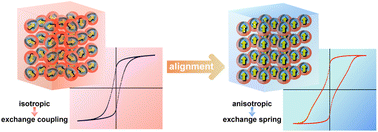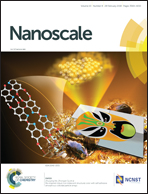FePt/Co core/shell nanoparticle-based anisotropic nanocomposites and their exchange spring behavior†
Abstract
Anisotropic exchange-coupled nanocomposites provide us a salient candidate for the new generation of permanent magnets owing to their huge predicted maximum energy product. However, previous research basically focused on thin films or bulk materials and the impact of easy-axis alignment on the exchange coupling behavior is not clear. Herein, strongly coupled FePt/Co core/shell nanoparticles with single-phase-like hysteresis loops were synthesized by the seed mediated method. Then, these nanoparticles were successfully aligned by the external magnetic field and fixed in an acrylic binder, so that FePt/Co core/shell nanoparticle-based anisotropic nanocomposites were obtained. The nanocomposites exhibited high degree of orientation as indicated by the increased remanence ratio from 0.62 for isotropic nanoparticles to 0.78 for anisotropic nanocomposites. However, a visible kink in the demagnetization curve was observed around the zero field, implying the exchange spring behavior. This result suggests that the aligned FePt cores impose a stronger overall dipolar field in Co shells and finally, force the Co shells to reverse at a low field before the switch of FePt cores. Our research extends the preparation methods of anisotropic hard/soft-phase nanocomposites and might be helpful for the design of high-performance anisotropic exchange-coupled nanocomposites.



 Please wait while we load your content...
Please wait while we load your content...